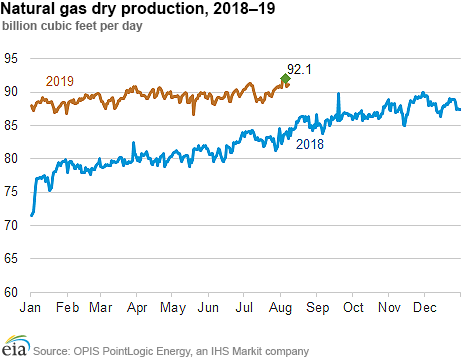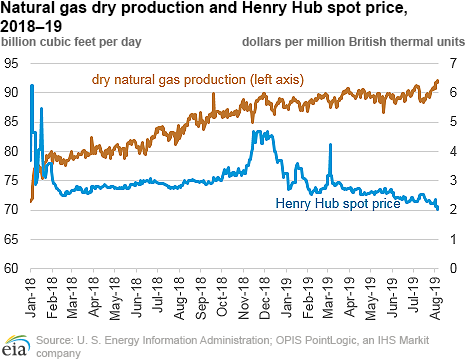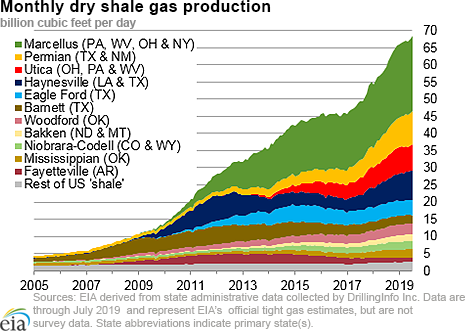In the News:
Natural gas production is at record-high levels despite low prices
U.S. natural gas production continued to increase in August despite relatively low natural gas spot prices, setting a new daily production record of 92.1 billion cubic feet per day (Bcf/d) on August 5, 2019, according to data from OPIS PointLogic Energy. Natural gas production increased by 1.5 Bcf/d (2.5%) between May and August 2019, led by production gains primarily in the Northeast. The northeastern region continues to be the largest natural gas-producing region in the country, accounting for 34% of the U.S. total. Average daily production levels in that region reached a new high of 32.2 Bcf/d in the first week of August, 1.5 Bcf/d higher than its monthly average in May.
Natural gas spot prices have been on a downward trend since early spring. Henry Hub spot natural gas prices are at a multi-year low, despite storage inventories ending withdrawal season at their lowest levels since 2014. On Monday, August 5, the spot price of natural gas at the Henry Hub closed at its lowest price since May 30, 2016, at $2.02 per million British thermal units (MMBtu)—down from $2.95/MMBtu on March 15.
Record levels of natural gas production growth continue to put downward pressure on prices. This summer, prices have continued to decline despite high levels of natural gas exports and increased consumption in the electric generation sector. Prices averaged $2.40/MMBtu in June and $2.37/MMBtu in July as growth in natural gas production continued to offset growth in consumption.
Natural gas storage has been absorbing a significant amount of this production. This injection season started with working natural gas inventories 30% lower than the previous five-year (2014–18) average during the same period. By the week ending August 9, working gas inventories were at 111 Bcf, or 4%, lower than the five-year average of 2,849 Bcf. EIA forecasts that natural gas storage levels will be about 3,700 Bcf by the end of October, which is slightly higher than the five-year average.
Overview:
(For the week ending Wednesday, August 14, 2019)
- Natural gas spot price movements were mixed this report week (Wednesday, August 7 to Wednesday, August 14). Henry Hub spot prices rose from $2.12 per million British thermal units (MMBtu) last Wednesday to $2.15/MMBtu yesterday.
- At the New York Mercantile Exchange (Nymex), the price of the September 2019 contract increased 6¢, from $2.083/MMBtu last Wednesday to $2.143/MMBtu yesterday. The price of the 12-month strip averaging September 2019 through August 2020 futures contracts rose 2¢/MMBtu to $2.323/MMBtu.
- Net injections to working gas totaled 49 billion cubic feet (Bcf) for the week ending August 9. Working natural gas stocks are 2,738 Bcf, which is 15% more than the year-ago level and 4% lower than the five-year (2014–18) average for this week.
- The natural gas plant liquids composite price at Mont Belvieu, Texas, fell by 6¢/MMBtu, averaging $4.33/MMBtu for the week ending August 14. The price of propane, butane, isobutane, and natural gasoline fell by 6%, 4%, 4%, and 2%, respectively. The price of ethane rose by 14%.
- According to Baker Hughes, for the week ending Tuesday, August 6, the natural gas rig count decreased by 2 to 169. The number of oil-directed rigs fell by 6 to 764. The total rig count decreased by 8, and it now stands at 934.
Prices/Supply/Demand:
Price movements mixed across the country. This report week (Wednesday, August 7 to Wednesday, August 14), Henry Hub spot prices rose 3¢ from $2.12/MMBtu last Wednesday to $2.15/MMBtu yesterday, reaching a high of $2.18/MMBtu on Tuesday. Temperatures were cooler than normal across the country, except in Texas and the Southeast, which experienced warmer-than-normal temperatures. At the Chicago Citygate, prices decreased 3¢ from $2.03/MMBtu last Wednesday to $2.00/MMBtu yesterday, reaching a weekly low of $1.90/MMBtu on Friday.
California prices rise. Prices at PG&E Citygate in Northern California rose 4¢, up from $2.53/MMBtu last Wednesday to $2.57/MMBtu yesterday. Prices at SoCal Citygate increased 16¢ from $3.02/MMBtu last Wednesday to $3.18/MMBtu yesterday. Prices in Southern California traded in a wide range of $1.31/MMBtu throughout the report week as a result of continued supply constraints in the area.
Northeast prices are mixed with cooler-than-normal temperatures. At the Algonquin Citygate, which serves Boston-area consumers, prices went up 4¢ from $2.05/MMBtu last Wednesday to a high of $2.09/MMBtu yesterday. At the Transcontinental Pipeline Zone 6 trading point for New York City, prices decreased 15¢ from a high of $2.07/MMBtu last Wednesday to $1.92/MMBtu yesterday.
Appalachia prices down. Tennessee Zone 4 Marcellus spot prices decreased 10¢ from $1.78/MMBtu last Wednesday to $1.68/MMBtu yesterday. Prices at Dominion South in southwest Pennsylvania fell 9¢ from $1.88/MMBtu last Wednesday to $1.79/MMBtu yesterday.
TETCO pipeline remains out of service. On August 1, Spectra Energy’s Texas Eastern Transmission, LP (TETCO) declared a force majeure in Danville, Kentucky, following an explosion. The explosion remains under investigation with no timeline for a return to service. Natural gas flows out of the Appalachia Basin have largely been unaffected by the event, according to S&P Platts Global, because new pipeline infrastructure in the region has allowed production to be re-routed to the Midwest.
Permian Basin prices climb throughout the week. Prices at the Waha Hub in West Texas, which is located near Permian Basin production activities, averaged -$0.03/MMBtu last Wednesday, $2.15/MMBtu lower than Henry Hub prices. Yesterday, prices at the Waha Hub averaged a weekly high of $1.46/MMBtu, 69¢/MMBtu lower than Henry Hub prices. Prices climbed throughout the week amid warmer-than-normal regional temperatures.
Amid the heat, the Electric Reliability Council of Texas (ERCOT)—the electric grid operator serving most of Texas—reported a record 74,531 megawatts in electricity demand on Monday. As a result, ERCOT asked customers to conserve power during periods of peak demand (from 3:00 p.m. to 7:00 p.m. on Tuesday) because Texas primarily uses electricity for cooling. Spot power prices on Wednesday tripled to $9,000 per megawatt hour with demand of 74,181 megawatts on Tuesday.
Supply is flat. According to data from PointLogic Energy, after reaching a new record last week, the average total supply of natural gas remained the same as in the previous report week, averaging 96.0 Bcf/d. Dry natural gas production remained constant week over week after hitting a record high of 92.1 Bcf/d last week on August 5 (see article above). Average net imports from Canada decreased by 4% from last week.
Total demand remains flat. Total U.S. consumption of natural gas was unchanged from the previous report week, averaging 71.0 Bcf/d according to data from PointLogic Energy. Natural gas consumed for power generation was flat, averaging 41.4 Bcf/d. Industrial sector consumption decreased by 1% week over week. In the residential and commercial sectors, consumption increased by 4%. Natural gas exports to Mexico increased 2%.
U.S. LNG exports decrease week over week. Seven liquefied natural gas (LNG) vessels (five from Sabine Pass, and one each from Cove Point and Corpus Christi LNG export terminals) with a combined LNG-carrying capacity of 25 Bcf departed the United States between August 8 and August 14, according to shipping data compiled by Bloomberg. One vessel was loading at the Sabine Pass and one at Corpus Christi terminals on Wednesday.
Storage:
Net injections into storage totaled 49 Bcf for the week ending August 9, compared with the five-year (2014–18) average net injections of 49 Bcf and last year's net injections of 35 Bcf during the same week. Working gas stocks totaled 2,738 Bcf, which is 111 Bcf lower than the five-year average and 357 Bcf more than last year at this time.
According to The Desk survey of natural gas analysts, estimates of the weekly net change from working natural gas stocks ranged from net injections of 50 Bcf to 64 Bcf, with a median estimate of 58 Bcf.
The average rate of net injections into storage is 32% higher than the five-year average so far in the refill season (April through October). If the rate of injections into storage matched the five-year average of 10.2 Bcf/d for the remainder of the refill season, total inventories would be 3,581 Bcf on October 31, which is 111 Bcf lower than the five-year average of 3,692 Bcf for that time of year.
More storage data and analysis can be found on the Natural Gas Storage Dashboard and the Weekly Natural Gas Storage Report.
See also:
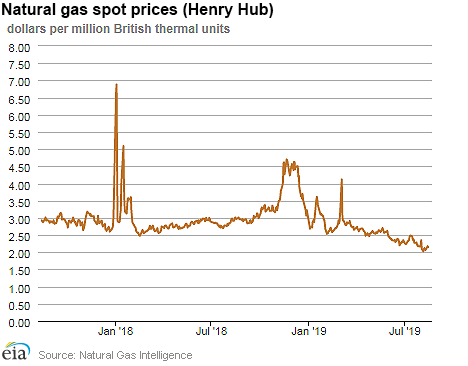
| Spot Prices ($/MMBtu) | Thu, 08-Aug |
Fri, 09-Aug |
Mon, 12-Aug |
Tue, 13-Aug |
Wed, 14-Aug |
|---|---|---|---|---|---|
| Henry Hub |
2.10 |
2.07 |
2.15 |
2.18 |
2.15 |
| New York |
1.85 |
1.69 |
1.91 |
1.86 |
1.92 |
| Chicago |
1.98 |
1.90 |
1.98 |
2.02 |
2.00 |
| Cal. Comp. Avg.* |
2.23 |
2.00 |
2.30 |
2.49 |
2.44 |
| Futures ($/MMBtu) | |||||
| September contract | 2.128 |
2.119 |
2.105 |
2.147 |
2.143 |
| October contract |
2.146 |
2.133 |
2.117 |
2.159 |
2.154 |
| *Avg. of NGI's reported prices for: Malin, PG&E Citygate, and Southern California Border Avg. | |||||
| Sources: Natural Gas Intelligence and CME Group as compiled by Bloomberg, L.P. | |||||
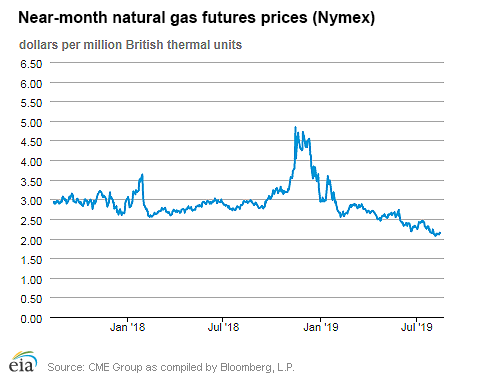
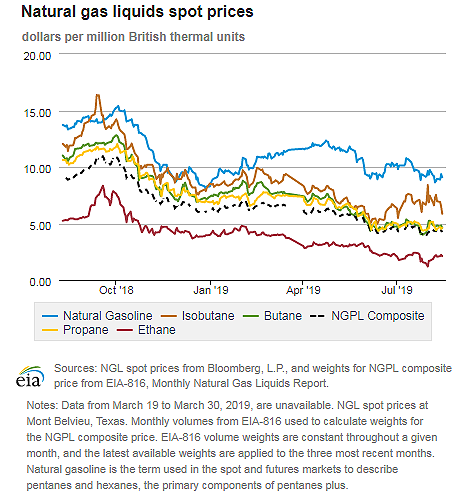
| U.S. natural gas supply - Gas Week: (8/8/19 - 8/14/19) | |||
|---|---|---|---|
Average daily values (Bcf/d): |
|||
this week |
last week |
last year |
|
| Marketed production | 102.6 |
102.3 |
93.6 |
| Dry production | 91.7 |
91.4 |
84.2 |
| Net Canada imports | 4.2 |
4.4 |
5.2 |
| LNG pipeline deliveries | 0.1 |
0.1 |
0.1 |
| Total supply | 96.0 |
95.9 |
89.5 |
|
Source: OPIS PointLogic Energy, an IHS Company | |||
| U.S. natural gas consumption - Gas Week: (8/8/19 - 8/14/19) | |||
|---|---|---|---|
Average daily values (Bcf/d): |
|||
this week |
last week |
last year |
|
| U.S. consumption | 71.0 |
70.7 |
68.6 |
| Power | 41.4 |
41.2 |
39.8 |
| Industrial | 21.0 |
21.2 |
21.2 |
| Residential/commercial | 8.6 |
8.3 |
7.5 |
| Mexico exports | 5.1 |
5.0 |
5.0 |
| Pipeline fuel use/losses | 6.5 |
6.4 |
6.0 |
| LNG pipeline receipts | 4.1 |
4.7 |
3.3 |
| Total demand | 86.6 |
86.8 |
82.9 |
|
Source: OPIS PointLogic Energy, an IHS Company | |||
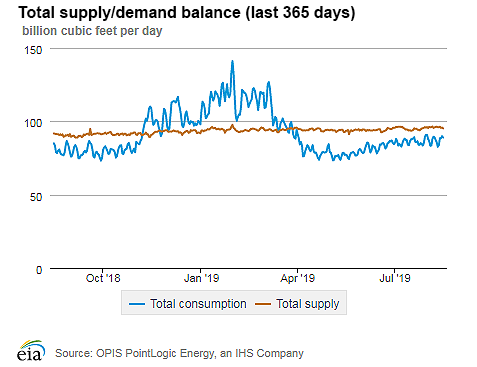
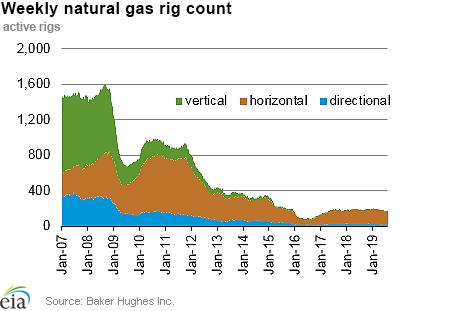
| Rigs | |||
|---|---|---|---|
Tue, August 06, 2019 |
Change from |
||
last week |
last year |
||
| Oil rigs | 764 |
-0.8% |
-12.1% |
| Natural gas rigs | 169 |
-1.2% |
-9.1% |
| Note: Excludes any miscellaneous rigs | |||
| Rig numbers by type | |||
|---|---|---|---|
Tue, August 06, 2019 |
Change from |
||
last week |
last year |
||
| Vertical | 52 |
-7.1% |
-24.6% |
| Horizontal | 817 |
-0.2% |
-11.6% |
| Directional | 65 |
-3.0% |
1.6% |
| Source: Baker Hughes Inc. | |||
| Working gas in underground storage | ||||
|---|---|---|---|---|
Stocks billion cubic feet (Bcf) |
||||
| Region | 2019-08-09 |
2019-08-02 |
change |
|
| East | 634 |
613 |
21 |
|
| Midwest | 729 |
701 |
28 |
|
| Mountain | 164 |
161 |
3 |
|
| Pacific | 272 |
272 |
0 |
|
| South Central | 939 |
941 |
-2 |
|
| Total | 2,738 |
2,689 |
49 |
|
|
Source: Form EIA-912, Weekly Underground Natural Gas Storage Report | ||||
| Working gas in underground storage | |||||
|---|---|---|---|---|---|
Historical comparisons |
|||||
Year ago (8/9/18) |
5-year average (2014-2018) |
||||
| Region | Stocks (Bcf) |
% change |
Stocks (Bcf) |
% change |
|
| East | 588 |
7.8 |
667 |
-4.9 |
|
| Midwest | 601 |
21.3 |
727 |
0.3 |
|
| Mountain | 151 |
8.6 |
179 |
-8.4 |
|
| Pacific | 240 |
13.3 |
294 |
-7.5 |
|
| South Central | 803 |
16.9 |
982 |
-4.4 |
|
| Total | 2,381 |
15.0 |
2,849 |
-3.9 |
|
| Source: Form EIA-912, Weekly Underground Natural Gas Storage Report | |||||
| Temperature – heating & cooling degree days (week ending Aug 08) | ||||||||
|---|---|---|---|---|---|---|---|---|
HDD deviation from: |
CDD deviation from: |
|||||||
| Region | HDD Current |
normal |
last year |
CDD Current |
normal |
last year |
||
| New England | 1 |
-2 |
1 |
46 |
3 |
-45 |
||
| Middle Atlantic | 0 |
-3 |
0 |
68 |
11 |
-22 |
||
| E N Central | 0 |
-4 |
-1 |
58 |
4 |
-13 |
||
| W N Central | 1 |
-2 |
-1 |
66 |
-1 |
-7 |
||
| South Atlantic | 0 |
0 |
0 |
101 |
6 |
-5 |
||
| E S Central | 0 |
0 |
0 |
93 |
0 |
-4 |
||
| W S Central | 0 |
0 |
0 |
136 |
12 |
11 |
||
| Mountain | 0 |
-3 |
0 |
100 |
26 |
6 |
||
| Pacific | 0 |
-2 |
0 |
67 |
20 |
-11 |
||
| United States | 0 |
-2 |
0 |
82 |
9 |
-9 |
||
|
Note: HDD = heating degree day; CDD = cooling degree day Source: National Oceanic and Atmospheric Administration | ||||||||
Average temperature (°F)
7-day mean ending Aug 08, 2019
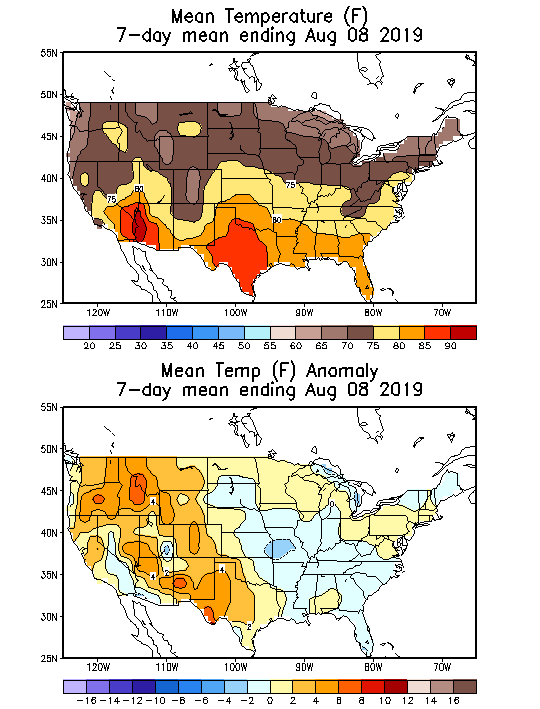
Source: National Oceanic and Atmospheric Administration
Deviation between average and normal (°F)
7-day mean ending Aug 08, 2019

Source: National Oceanic and Atmospheric Administration

